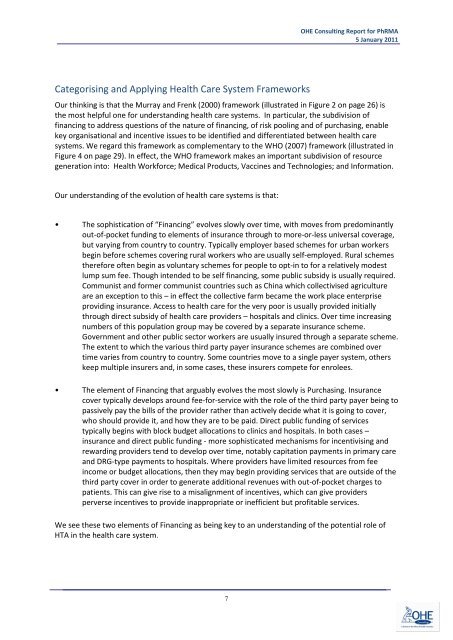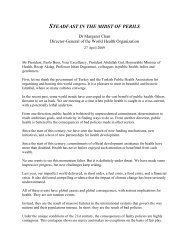The Evolution of HTA in Emerging Markets Health-Care ... - TREE
The Evolution of HTA in Emerging Markets Health-Care ... - TREE
The Evolution of HTA in Emerging Markets Health-Care ... - TREE
Create successful ePaper yourself
Turn your PDF publications into a flip-book with our unique Google optimized e-Paper software.
OHE Consult<strong>in</strong>g Report for PhRMA<br />
5 January 2011<br />
Categoris<strong>in</strong>g and Apply<strong>in</strong>g <strong>Health</strong> <strong>Care</strong> System Frameworks<br />
Our th<strong>in</strong>k<strong>in</strong>g is that the Murray and Frenk (2000) framework (illustrated <strong>in</strong> Figure 2 on page 26) is<br />
the most helpful one for understand<strong>in</strong>g health care systems. In particular, the subdivision <strong>of</strong><br />
f<strong>in</strong>anc<strong>in</strong>g to address questions <strong>of</strong> the nature <strong>of</strong> f<strong>in</strong>anc<strong>in</strong>g, <strong>of</strong> risk pool<strong>in</strong>g and <strong>of</strong> purchas<strong>in</strong>g, enable<br />
key organisational and <strong>in</strong>centive issues to be identified and differentiated between health care<br />
systems. We regard this framework as complementary to the WHO (2007) framework (illustrated <strong>in</strong><br />
Figure 4 on page 29). In effect, the WHO framework makes an important subdivision <strong>of</strong> resource<br />
generation <strong>in</strong>to: <strong>Health</strong> Workforce; Medical Products, Vacc<strong>in</strong>es and Technologies; and Information.<br />
Our understand<strong>in</strong>g <strong>of</strong> the evolution <strong>of</strong> health care systems is that:<br />
<br />
<br />
<strong>The</strong> sophistication <strong>of</strong> “F<strong>in</strong>anc<strong>in</strong>g” evolves slowly over time, with moves from predom<strong>in</strong>antly<br />
out-‐<strong>of</strong>-‐pocket fund<strong>in</strong>g to elements <strong>of</strong> <strong>in</strong>surance through to more-‐or-‐less universal coverage,<br />
but vary<strong>in</strong>g from country to country. Typically employer based schemes for urban workers<br />
beg<strong>in</strong> before schemes cover<strong>in</strong>g rural workers who are usually self-‐employed. Rural schemes<br />
therefore <strong>of</strong>ten beg<strong>in</strong> as voluntary schemes for people to opt-‐<strong>in</strong> to for a relatively modest<br />
lump sum fee. Though <strong>in</strong>tended to be self f<strong>in</strong>anc<strong>in</strong>g, some public subsidy is usually required.<br />
Communist and former communist countries such as Ch<strong>in</strong>a which collectivised agriculture<br />
are an exception to this – <strong>in</strong> effect the collective farm became the work place enterprise<br />
provid<strong>in</strong>g <strong>in</strong>surance. Access to health care for the very poor is usually provided <strong>in</strong>itially<br />
through direct subsidy <strong>of</strong> health care providers – hospitals and cl<strong>in</strong>ics. Over time <strong>in</strong>creas<strong>in</strong>g<br />
numbers <strong>of</strong> this population group may be covered by a separate <strong>in</strong>surance scheme.<br />
Government and other public sector workers are usually <strong>in</strong>sured through a separate scheme.<br />
<strong>The</strong> extent to which the various third party payer <strong>in</strong>surance schemes are comb<strong>in</strong>ed over<br />
time varies from country to country. Some countries move to a s<strong>in</strong>gle payer system, others<br />
keep multiple <strong>in</strong>surers and, <strong>in</strong> some cases, these <strong>in</strong>surers compete for enrolees.<br />
<strong>The</strong> element <strong>of</strong> F<strong>in</strong>anc<strong>in</strong>g that arguably evolves the most slowly is Purchas<strong>in</strong>g. Insurance<br />
cover typically develops around fee-‐for-‐service with the role <strong>of</strong> the third party payer be<strong>in</strong>g to<br />
passively pay the bills <strong>of</strong> the provider rather than actively decide what it is go<strong>in</strong>g to cover,<br />
who should provide it, and how they are to be paid. Direct public fund<strong>in</strong>g <strong>of</strong> services<br />
typically beg<strong>in</strong>s with block budget allocations to cl<strong>in</strong>ics and hospitals. In both cases –<br />
<strong>in</strong>surance and direct public fund<strong>in</strong>g -‐ more sophisticated mechanisms for <strong>in</strong>centivis<strong>in</strong>g and<br />
reward<strong>in</strong>g providers tend to develop over time, notably capitation payments <strong>in</strong> primary care<br />
and DRG-‐type payments to hospitals. Where providers have limited resources from fee<br />
<strong>in</strong>come or budget allocations, then they may beg<strong>in</strong> provid<strong>in</strong>g services that are outside <strong>of</strong> the<br />
third party cover <strong>in</strong> order to generate additional revenues with out-‐<strong>of</strong>-‐pocket charges to<br />
patients. This can give rise to a misalignment <strong>of</strong> <strong>in</strong>centives, which can give providers<br />
perverse <strong>in</strong>centives to provide <strong>in</strong>appropriate or <strong>in</strong>efficient but pr<strong>of</strong>itable services.<br />
We see these two elements <strong>of</strong> F<strong>in</strong>anc<strong>in</strong>g as be<strong>in</strong>g key to an understand<strong>in</strong>g <strong>of</strong> the potential role <strong>of</strong><br />
<strong>HTA</strong> <strong>in</strong> the health care system.<br />
7








